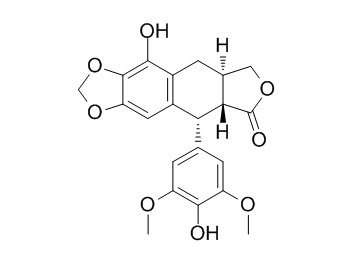alpha-Peltatin
alpha-Peltatin is a lignan podophyllotoxin, it shows phytotoxicity.
Inquire / Order:
manager@chemfaces.com
Technical Inquiries:
service@chemfaces.com
Tel:
+86-27-84237783
Fax:
+86-27-84254680
Address:
1 Building, No. 83, CheCheng Rd., Wuhan Economic and Technological Development Zone, Wuhan, Hubei 430056, PRC
Providing storage is as stated on the product vial and the vial is kept tightly sealed, the product can be stored for up to
24 months(2-8C).
Wherever possible, you should prepare and use solutions on the same day. However, if you need to make up stock solutions in advance, we recommend that you store the solution as aliquots in tightly sealed vials at -20C. Generally, these will be useable for up to two weeks. Before use, and prior to opening the vial we recommend that you allow your product to equilibrate to room temperature for at least 1 hour.
Need more advice on solubility, usage and handling? Please email to: service@chemfaces.com
The packaging of the product may have turned upside down during transportation, resulting in the natural compounds adhering to the neck or cap of the vial. take the vial out of its packaging and gently shake to let the compounds fall to the bottom of the vial. for liquid products, centrifuge at 200-500 RPM to gather the liquid at the bottom of the vial. try to avoid loss or contamination during handling.
Cell Physiol Biochem.2017, 43(4):1425-1435
South African J of Plant&Soil2018, 29-32
Separations2023, 10(11), 567;
Oncol Lett.2020, 20(4):122.
Pharmaceuticals (Basel).2024, 17(8):988.
Molecules2022, 27(12):3903.
Molecules.2023, 28(13):4971.
Pharmaceuticals (Basel).2022, 15(5):591.
Analytical sci. & Tech2016, 186-193
Drug Dev Res.2022, 83(7):1673-1682.
Related and Featured Products
Cancer research, 1983, 43(2):505.
Podophyllotoxin-resistant mutants of Chinese hamster ovary cells: cross-resistance studies with various microtubule inhibitors and podophyllotoxin analogues.[Reference:
WebLink]
METHODS AND RESULTS:
The cross-resistances of several mutants of Chinese hamster ovary cells which have been obtained after one and two selection steps in the presence of the microtubule inhibitor podophyllotoxin (PodRI and PodRII mutants, respectively) towards various other inhibitors of microtubule assembly (e.g., colchicine, Colcemid, vinblastine, griseofulvin, maytansine, steganacin, nocodazole, and taxol) have been examined. Based upon their specific patterns of cross-resistance/sensitivity to various microtubule inhibitors, both the PodRI and PodRII classes of mutants appear to be of more than one kind. Studies on the binding of [3H]podophyllotoxin to cytoplasmic extracts indicate that one of the PodRII mutants which has been shown previously to be affected in a Mr 66,000 to 68,000 microtubule-associated protein shows reduced binding of the drug in comparison to the parental PodS and PodRI cells. The different PodRI and PodRII mutants exhibited proportionally increased cross-resistances to various podophyllotoxin analogues (e.g., deoxypodophyllotoxin, epipodophyllotoxin, beta-peltatin, 4'-demethylpodophyllotoxin, alpha-Peltatin, podophyllotoxin-beta-D-glucoside, beta-peltatin-beta-D-glucoside, picropodophyllotoxin, and podophyllic acid) which possess microtubule-inhibitory activity. However, with the exception of one PodRI class of mutant, none of the mutants exhibited any cross-resistance to 4'-demethylepipodophyllotoxin thenylidine-beta-D-glucoside and 4'-demethylepipodophyllotoxin ethylidine-beta-D-glucoside, the 2 podophyllotoxin analogues which lack microtubule-inhibitory activity. The cross-resistance studies with these mutants, which, based upon the biochemical studies and their highly specific patterns of cross-resistance, are presumably affected in microtubules, provide some very novel insights into the mechanisms of action of various microtubule inhibitors.
CONCLUSIONS:
The results presented in this paper also show that the cross-resistance studies with the set of podophyllotoxin-resistant mutants provide a sensitive and highly specific screening procedure for identifying compounds which possess podophyllotoxin-like activity and for investigating the structure-activity relationship among them. The results of structure-activity relationship studies for the various podophyllotoxin analogues examined are discussed.
Pesticide Biochemistry & Physiology, 2002, 72(1):45-54.
Aryltetralin Lignans Inhibit Plant Growth by Affecting the Formation of Mitotic Microtubular Organizing Centers.[Reference:
WebLink]
The aryltetralin lignans podophyllotoxin, α-peltatin(alpha-Peltatin), and β-peltatin, their respective O-β--glucosides, and the semisynthetic derivative etoposide were tested for phytotoxicity.
METHODS AND RESULTS:
The aglycones were more potent inhibitors than their respective glucosides, and podophyllotoxin was the most active natural lignan tested. These compounds were more active against rye (Lolium multiflorum L.) and onion (Allium cepa L.) than lettuce (Lactuca sativa L.). The semisynthetic lignan etoposide was more active than any of the natural analogues and was phytotoxic to both monocotyledonous and dicotyledonous species. Inhibition of root growth was the main developmental response observed on plants tested with the lignans.
At the cellular level, podophyllotoxin and etoposide caused similar symptoms in actively dividing meristematic cells of onion root tips. All phases of mitosis were inhibited by nearly 50%, relative to the controls. Both compounds also induced abnormal star anaphase chromosomal configurations.
CONCLUSIONS:
While the precise molecular mechanism of action of these compounds remains to be identified in plants, a primary effect is the alteration of the formation of the spindle microtubular organization centers, resulting in the formation of multiple spindle poles and an asymmetrical convergence of the chromosomes.
Química Nova, 2001, 24(6):730-733.
Lignans and triterpenes from cytotoxic extract of Eriope blanchetii.[Reference:
WebLink]
METHODS AND RESULTS:
This phytochemical study performed with the cytotoxic chloroformic extract of Eriope blanchetii (Benth.) Harley was the first work with this species and describes from aerial parts the isolation of two lignans of podophylotoxin type named β-peltatin and α-peltatin(alpha-Peltatin). Besides them it was obtained four triterpenes; oleanolic acid, ursolic acid, 2α,3β-dihydroxy-urs-12-en-28-olic acid, 2α,3β,19α-trihydroxy-urs-12-en-28-olic acid, named tormentic acid and 3β-glucosyl-sitosterol. The compounds were identified by analysis of their spectral data.



